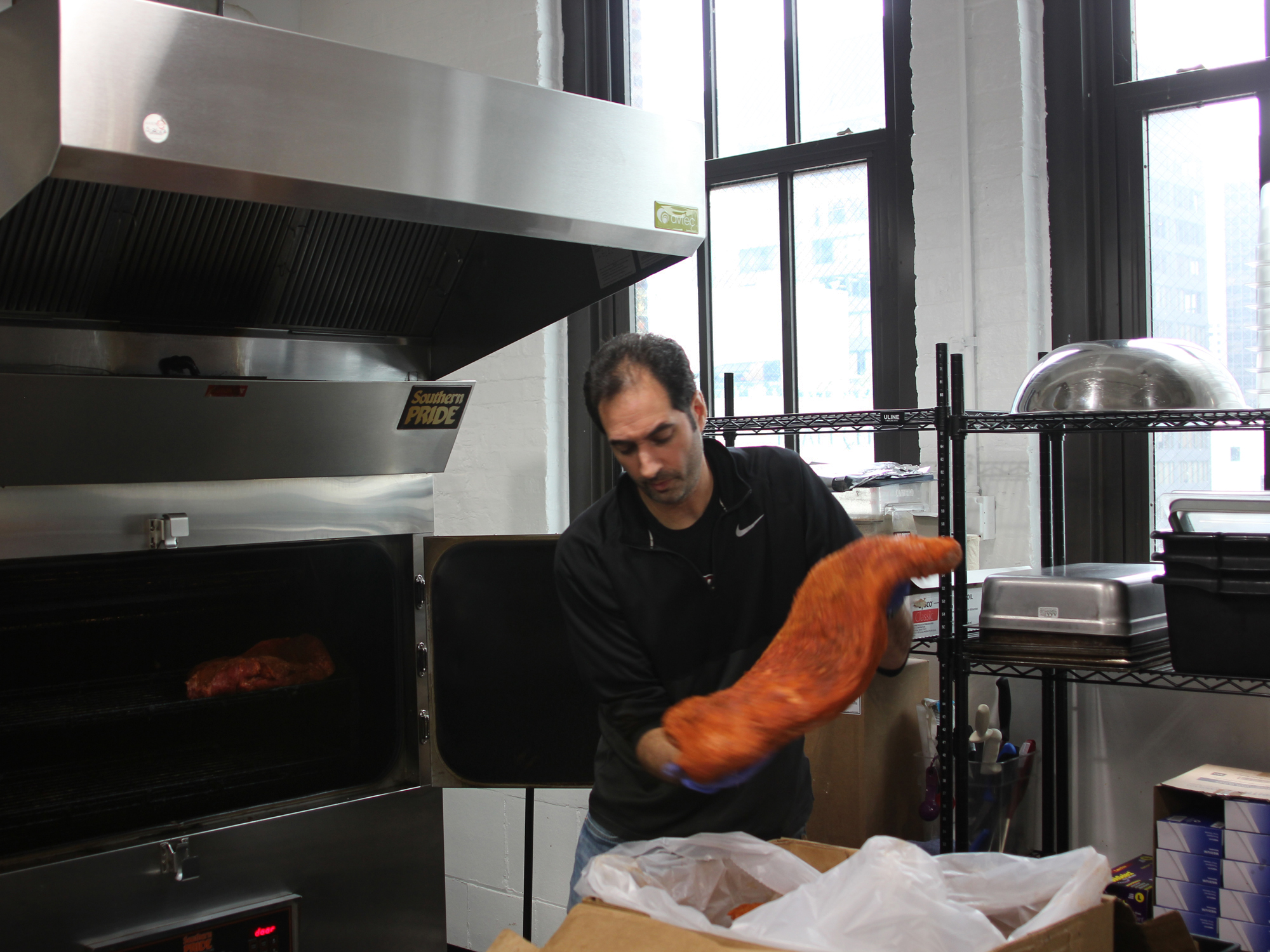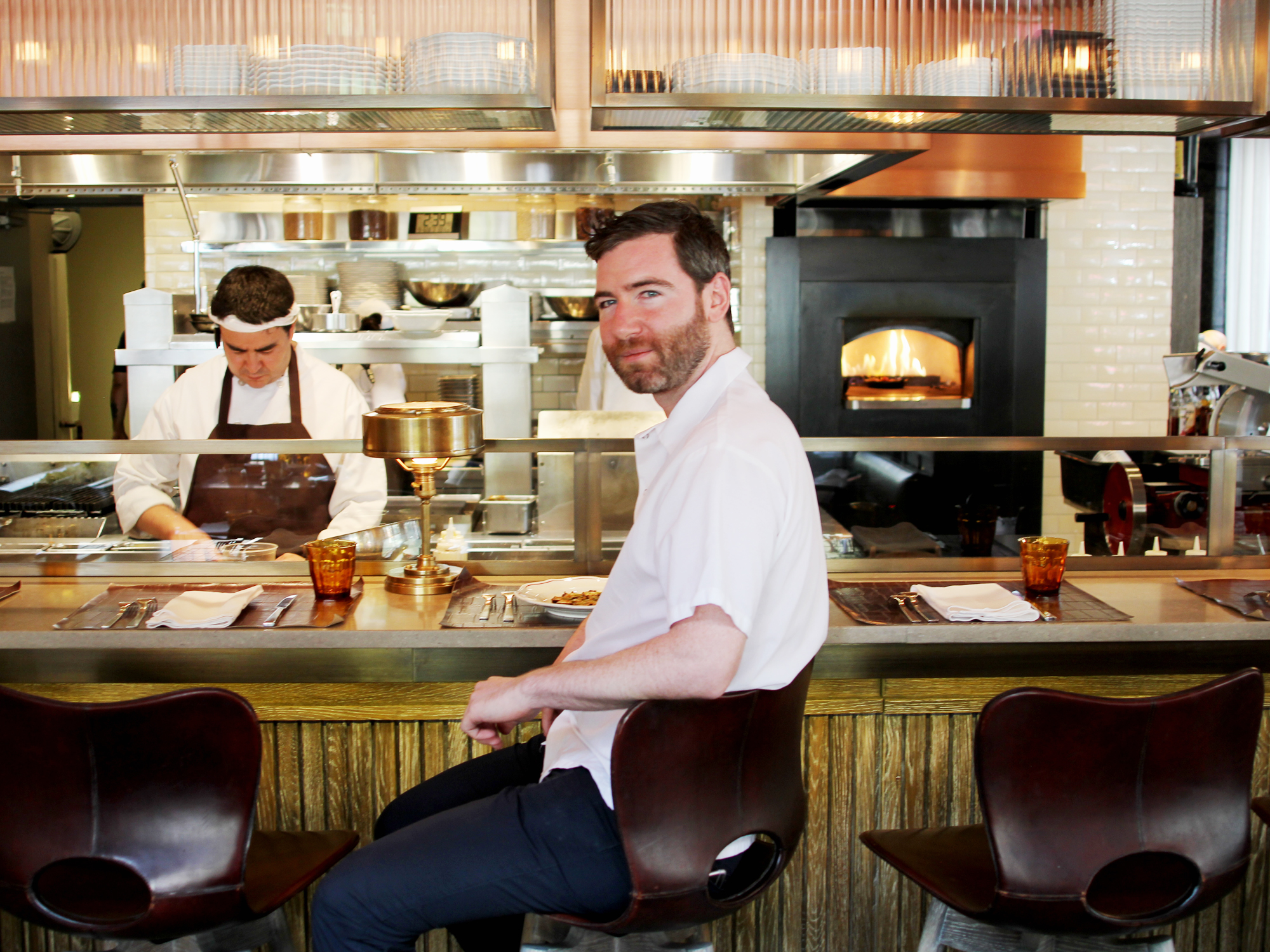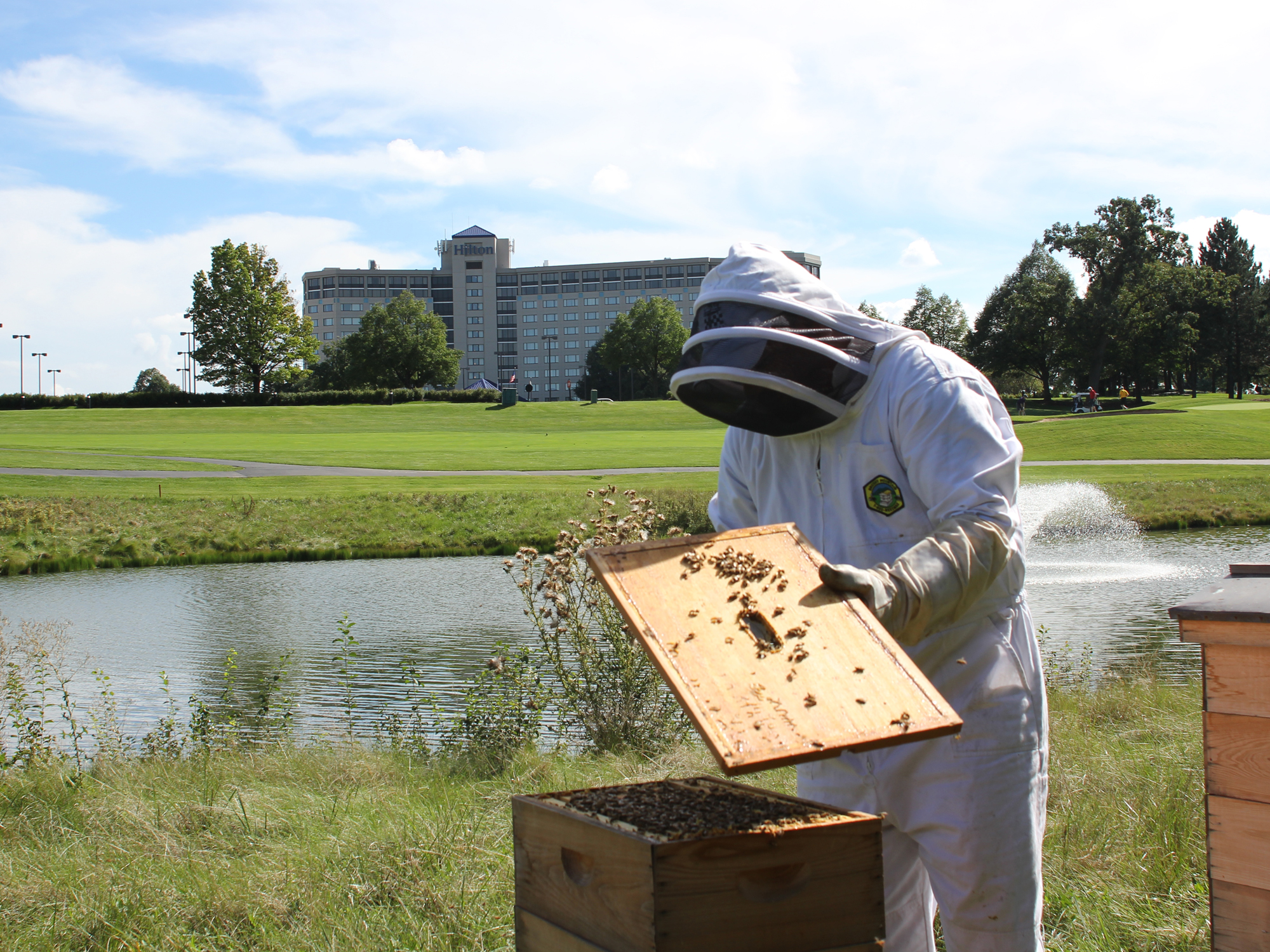WE WERE NEARING HARLEM ON THE KENNEDY and the question posed by Willie Clay, our emcee or, as he put it, our “Steve Harvey” for the trip to Heritage Prairie Farms between St. Charles and Elburn, was: what do you add to a Croque Monsieur to make it a Croque Madame? I consulted with my teammate—we’d paired up through the fact that she was sitting directly behind me on the posh bus with black leather seats and blue strip lighting. Despite the fact that I’ve eaten in more coffeeshops serving old-school items than is good for me, I honestly didn’t know—jam?
“Egg,” she mouthed, so no one else would hear.
I nodded my acceptance of the answer as better than anything I had, and she scribbled it down. The ride to the farm would take close to two hours in rush hour traffic, and whoever came up with this trivia contest to make most of that time sail by (and then found 60 good food and drink questions) earned their pay that day.
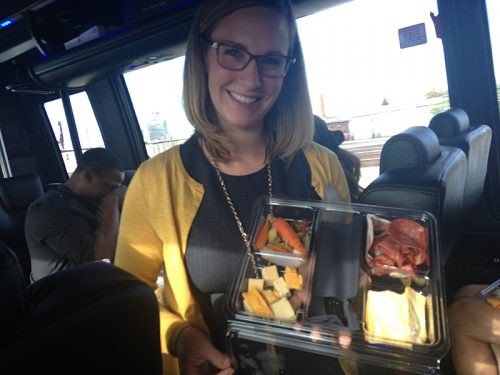
The Marriott’s aptly-named Shannon Braniff played stewardess, offering us snacks on the drive
There were about 25 of us on the bus, meeting about the same number at the farm. We were a mixed assortment, from personnel at the Marriott Magnificent Mile hotel (like Willie) to what appeared to be some treasured corporate clients, and a small number of media—mainly myself and a couple of Instagram influencers, known by their handles (@Chicagomunchies and @Adamsoko and @Jackiesaland, who also plays a waitress on Empire—her wine pouring would prove to be impeccable). Our destination was a working farm, but also a bit of what is often called agri-tainment—a farm with professional facilities for weddings and events, as well as its own schedule of attractions, like pizza nights through the summer.
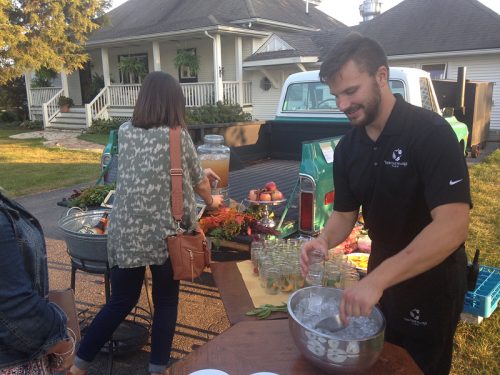
Our bus stopped and we were greeted by a stand offering two kinds of cocktails, one of them served in a glass that had been filled with smoke—it didn’t take long for that cocktail trend to make it out here to the farm, clearly. On this pleasant summer night, the pink sun setting behind the white barns, a guy with a guitar playing “Heart of Gold” and “Peaceful Easy Feeling,” it was as idyllic a version of farm life as city folks could ask for as a backdrop for their event—the messier parts of it edited out for our citified eyes (the livestock, ranging from chickens to pigs, were a few hundred yards away, on the acreage to the south), while we drank our smoked cocktails, and nibbled on foie gras macarons, and the Instagrammers shared it all with their followers.

@Chicagomunchies caught in the act of both eating and Influencing
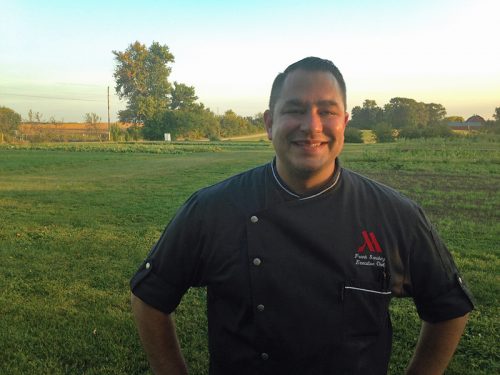
Chef Frank Sanchez, in front of things being grown specifically for his kitchen
STILL, AS ARTFULLY CREATED FOR GUESTS AS IT IS, it is a real farm, not just a stage set of one, and we were here because for about a decade, this Marriott has been buying produce from the farm. Frank Sanchez has been the executive chef of Harvest, the hotel’s main restaurant, for the last three years, but he inherited and continued the program started by his predecessor, Myk Banas. “He found this little farm, and decided to start a relationship with them,” Sanchez explained. “It started as a little 12-acre farm, and we used to buy up all the produce. I think they’ve tripled in size since then.”
Owner Nate Sumner told the story from his point of view. “I’ve been here since we started in 2008, and my [now-]wife joined in 2010. We’ve been operating it since 2012, and bought it in the last year,” he explained. “It wasn’t what you see now—we started with some beehives and a few vegetables. It’s grown to 50 hives, and over 20 acres of land, about half of which is in vegetable production, hogs, turkeys, chickens—and then of course we do weddings, corporate events, we have a full-blown commercial kitchen, executive chef, staff, all that jazz now.”
Sumner wasn’t born to the farm life—he grew up in Wheaton, and joked that “my extensive outdoor labor was that I mowed the lawn once when my dad was out of town.” He got into growing food by way of cooking it—”I’m one of the Food Network generation, I saw it on TV and said, ‘I’m gonna do that.'” He went to culinary school in California, worked in some kitchens there and in Chicago, “and through that process, began to really understand what good food is. But as a cook, you drink Red Bull and eat a frozen pizza at 3 am, you know? I got to know some farmers, and realized that they were the guys who really know what good food is.”
“The Marriott was not our first customer, but they were definitely our first major customer,” Sumner said. “We met back when we were at the Green City Market with our vegetables and honey in 2009. Chef Myk, Joe and Nathan ponied up to the table and said they wanted to work with us. I’m not gonna lie, I was a bit skeptical that an organization as large as theirs would want to work with a farm as small as ours. But by 2010 we expanded our production, and a huge part of that was growing specifically for them, and we’ve been good friends and good customers ever since.”
Other guys have come and gone. Everybody has cool ideas, and it starts off really good… and then, like, the authenticity kind of fades.
I asked Chef Sanchez how the relationship works each year, “In the winter, we’ll talk on the phone and work up a farm plan for him. We’ll tell him what we want to see, and then I just make a commitment that I’m going to buy it from him. We commit to a menu, and he commits to growing it. That’s a pretty huge commitment from both ends.”
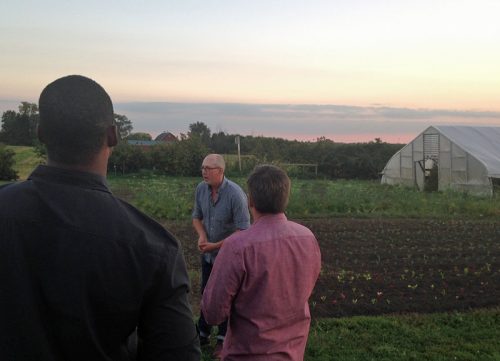
Nate Sumner explaining the farm’s workings to the guests
“And we help them when they have a surplus of items,” Sanchez continued. “Whatever it may be, we’re just going to take it off their hands, because we’re a large hotel, we’ll figure out what to do with it. We want things at the peak flavor, in the peak time, and if they have extra of it, we can take it.” He estimates that in the summer 50-60% of all produce used in the hotel comes from Heritage Prairie Farm—”That’s a huge amount, we feed a million people a year.”
Sumner said, “We grow over 250 varieties of 40 different vegetables, and I would say every one of them has made it through the kitchen at Marriott. We’re sending them cases and cases of product, whatever’s in season. We do a lot of cool micro greens for them, they love the heirloom tomatoes. But they also love the fun stuff—tonight’s salad has some baby hakurei turnips, they’re always down for whatever I just have five pounds of or whatever, take it and throw it in a special or something like that. But working with Marriott has been great, because if I have a lot of something I can easily move it.”
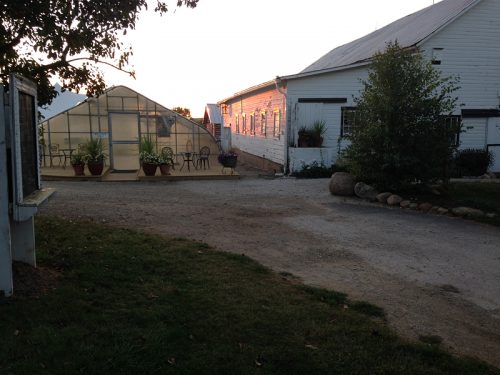
I asked him if this has become a typical model—if there are any other hotels that he works with this way. “Yes, but not as significantly,” he said. “I’m on the phone with Marriott two or three times a week. Other guys have come and gone. Everybody has cool ideas, and it starts off really good… and then, like, the authenticity kind of fades. They’re into putting it on their menu, but they’re not into putting it into action.”
“Let’s face it, it’s not that hard, but it’s not as easy to work with a local producer,” he said. “There are hotels right in our own backyard that are getting local stuff from a distributor from Michigan or wherever. What we’ve found is, they don’t really want to put the effort into it. These guys have been the real deal, and what I’ve been grateful for is that it hasn’t just been one person’s baby, the whole local thing. It really is the culture that exists at this organization.”
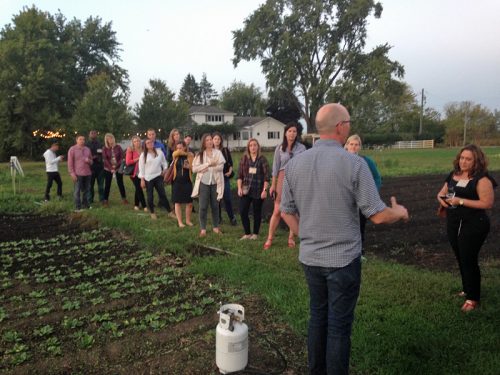
IT’S BECAUSE OF THEIR CLOSE RELATIONSHIP that the Marriott chefs get a privilege no one else enjoys—they’re the only ones who get to cook on the farm, which otherwise requires the use of their kitchen staff for events. As Sanchez and his team worked in the kitchen, Sumner took our group for a little tour—which is to say we walked around the closest patches, each exactly the size of the portable green houses behind them, which can be moved around to cover whatever needs the cover at the moment.
Sumner talked about preparing for winter—one of his favorite things is growing spinach in the winter, because the cold increases the brix level (the sweetness), which both makes for a delicious product and allows the spinach to freeze and thaw without harm to the texture of the plant.
One question inevitably came up—we may have been in the country, but we weren’t far from suburban sprawl, subdivisions and malls popping up like weeds. Some construction equipment sat across the street, ominously. “That’s for a new forest preserve. It’s great that it’s going to be a forest preserve, it’s too bad they’re putting a great big ugly building right opposite us,” he said.
The good news is that Kane County, he said, is open to keeping the rural life going and not just becoming more parking lots for Chicago. He says the land straight to the west is owned by a big developer, but they’re hoping to keep it as open land, not a subdivision.
“You know, it’s pretty amazing, I take these little kale seeds, and I plant them, and I pay some guys to pick it and they pay their bills,” he said, getting wound up with enthusiasm as he spoke, “and I sell it to my friend Paul who owns Blue Goose Market, and he’s going to sell it to the customer who’s going to eat, and he’s going to pay his taxes and pay his bills. And what’s happening is, these seeds that we’re putting in the ground, these little seeds of nothing, are multiplying two, three times over, and creating abundance and creating wealth and creating jobs and creating sustainability.”
“Not just for the environment, but so people can live, from these freaking little seeds. And that’s become my passion —not just the kale, but the power that’s behind it.”
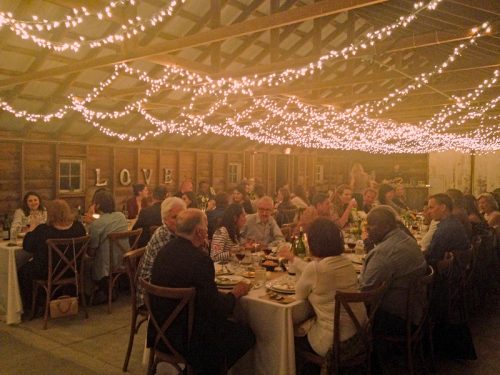
Michael Gebert is all about the eatin’-tainment as editor of Fooditor.
Latest
Join the Discussion
After you comment, click Post. If you're not already logged in you will be asked to log in or register with Disqus.





